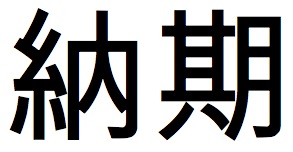The second most important project manager word is 納期 (のうき). This shares the first character with 納品, but is in the order ADJECTIVE + NOUN, I think. I believe that you could draw out the compound to something like 納める期 or 納める期間, in which case the verb acts as an adjective. So literally “delivery period.”
The phrase I hear most often is 納期教えてください!
In my office, there are Japanese coordinators that receive translation requests directly from the client and then prepare estimates for the projects. In order to complete the estimate, they have to provide a 納期.
That’s where I come in. I take a look at the volume of the project and give the Japanese coordinator the 納期 – the number of business days it will take to complete a project. This includes the time it will take the translator to translate the material and the time it will take me to check and revise the translated text. I use the numbers discussed previously to come up with an estimated number of business days. The beautiful thing about 営業日 (えいぎょうび) is that they don’t include the weekend. Holy is the project that spans the weekend, for it giveth the translator extra days to work and therefore extra days to revise the document which in turn ensureth a more accurate and pleasant-reading translation.
When I get asked, 納期は? I usually answer with something like, 4、5営業日 depending on the volume. The client will take a look at the estimate the Japanese coordinator submits and then give the official go if everything is in order, at which point we determine the specific delivery date based on the 納期 we provided.


Nice, a two-for-one. 営業日 is a good one to know, as well. 勉強になった!